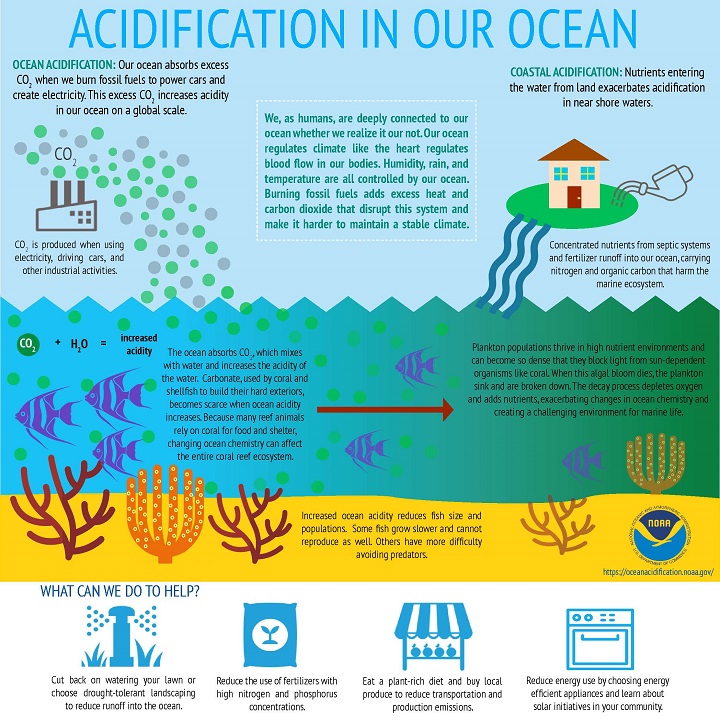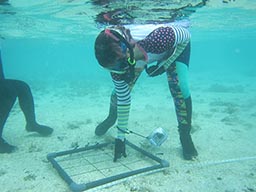- ABOUT US
- PROGRAM AREAS
- CONSERVATION APPROACH
- EDUCATION
- MULTIMEDIA
- Cut back on watering your lawn or choose drought-tolerant landscaping to reduce runoff into the ocean.
- Reduce the use of fertilizers with high nitrogen and phosphorus concentrations.
- Eat a plant-rich diet and buy local produce to reduce transportation and production emissions.
- Reduce energy use by choosing energy efficient appliances and learn about solar initiatives in your community.
Acidification in our Ocean
This infographic describes both ocean and coastal acidification and how they can impact marine life such as corals and fish, along with what we can do to help.
For more information and to download the infographic, visit the NOAA Ocean Acidification Program.

Infographic Transcript: Acidification in our Ocean
We, as humans, are deeply connected to our ocean whether we realize it or not. Our ocean regulates climate like the heart regulates blood flow in our bodies. Humidity, rain, and temperature are all controlled by our ocean. Burning fossil fuels adds excess heat and carbon dioxide that disrupt this system and make it harder to maintain a stable climate.
Ocean Acidification: Our ocean absorbs excess carbon dioxide (CO2) when we burn fossil fuels to power cars and create electricity. This excess CO2 increases acidity in our ocean on a global scale.
CO2 is produced when using electricity, driving cars, and other industrial activities.
CO2 (carbon dioxide) + H2O (water) = increased acidity
The ocean absorbs CO2, which mixes with water and increases the acidity of the water. Carbonate, used by coral and shellfish to build their hard exteriors, becomes scarce when ocean acidity increases. Because many reef animals rely on coral for food and shelter, changing ocean chemistry can affect the entire coral reef ecosystem.
Increased ocean acidity reduces fish size and populations. Some fish grow slower and cannot reproduce as well. Others have more difficulty avoiding predators.
Coastal Acidification: Nutrients entering the water from land exacerbates acidification in near shore waters.
Concentrated nutrients from septic systems and fertilizer runoff into our ocean, carrying nitrogen and organic carbon that harm the marine ecosystem.
Plankton populations thrive in high nutrient environments and can become so dense that they block light from sun-dependent organisms like coral. When this algal bloom dies, the plankton sink and are broken down. The decay process depletes oxygen and adds nutrients, exacerbating changes in ocean chemistry and creating a challenging environment for marine life.
What can we do to help?
About Us

The NOAA Coral Reef Conservation Program was established in 2000 by the Coral Reef Conservation Act. Headquartered in Silver Spring, Maryland, the program is part of NOAA's Office for Coastal Management.

The Coral Reef Information System (CoRIS) is the program's information portal that provides access to NOAA coral reef data and products.
Work With US
U.S. Coral Reef Task Force
Funding Opportunities
Employment
Fellowship Program
Contracting Assistance
Graphic Identifier
Featured Stories Archive

Access the archive of featured stories here...
Feedback
Thank you for visiting NOAA’s Coral Reef Conservation Program online. Please take our website satisfaction survey. We welcome your ideas, comments, and feedback. Questions? Email coralreef@noaa.gov.
Stay Connected
Contact Us
NOAA’s Coral Reef Conservation Program
SSMC4, 10th Floor
1305 East West Highway
Silver Spring, MD 20910
coralreef@noaa.gov
